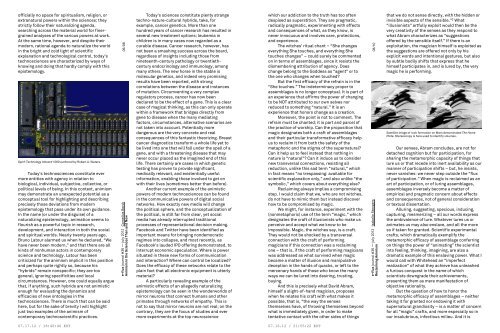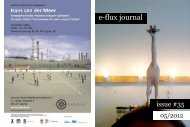Create successful ePaper yourself
Turn your PDF publications into a flip-book with our unique Google optimized e-Paper software.
officially no space for spiritualism, religion, or<br />
extranatural powers within the sciences; they<br />
strictly follow their naturalizing agenda,<br />
searching across the material world for finergrained<br />
analyses of the various powers at work.<br />
At the same time, however, and despite their<br />
modern, rational agenda to naturalize the world<br />
in the bright and cold light of scientific<br />
explanation and technological control, today’s<br />
technosciences are characterized by ways of<br />
knowing and doing that hardly comply with this<br />
epistemology.<br />
Spirit Technology Inboard 1000 authored by Robert A. Waters.<br />
Today’s technosciences constitute ever<br />
more entities with agency in relation to<br />
biological, individual, subjective, collective, or<br />
political levels of being. In this context, animism<br />
may demonstrate an unexpected potential as a<br />
conceptual tool for highlighting and describing<br />
precisely those deviations from modern<br />
epistemology that pass under its own guidance.<br />
In the name (or under the disguise) of a<br />
naturalizing epistemology, animation seems to<br />
flourish as a powerful topic in research,<br />
development, and interaction in both the social<br />
and spiritual worlds. Nearly twenty years ago,<br />
Bruno Latour alarmed us when he declared, “We<br />
have never been modern,” and that there are all<br />
kinds of nonhuman actors in contemporary<br />
science and technology. Latour has been<br />
criticized for the animism implicit in this position<br />
and perhaps quite rightly so, because his<br />
“hybrids” remain nonspecific; they are too<br />
general, ignoring specificities and local<br />
circumstances. However, one could equally argue<br />
that, if anything, such hybrids are not animistic<br />
enough for evaluating the dynamics and<br />
efficacies of new ontologies in the<br />
technosciences. There is much that can be said<br />
here, but for the sake of brevity I will highlight<br />
just two examples of the animism of<br />
contemporary technoscientific practices.<br />
07.17.12 / 18:46:40 EDT<br />
06/08<br />
e-flux journal #36 — july 2012 Cornelius Borck<br />
<strong>Animism</strong> in the Sciences Then and Now<br />
Today's sciences constitute plenty strange<br />
techno-nature-cultural hybrids, take, for<br />
example, cancer genetics. More than one<br />
hundred years of cancer research has resulted in<br />
several new treatment options; leukemia in<br />
children is in many cases now regarded as a<br />
curable disease. Cancer research, however, has<br />
not been a smashing success across the board,<br />
regardless of insights including those from<br />
nineteenth-century pathology or twentiethcentury<br />
endocrinology and immunology, among<br />
many others. The new horse in the stable is<br />
molecular genetics, and indeed very promising<br />
results have been reported, with strong<br />
correlations between the disease and instances<br />
of mutation. Circumventing a very complex<br />
regulatory process, cancer has now been<br />
declared to be the effect of a gene. This is a clear<br />
case of magical thinking, as this can only operate<br />
within a framework that bridges directly from<br />
gene to disease when the many mediating<br />
factors, circumstances, alternative scenarios are<br />
not taken into account. Potentially more<br />
dangerous are the very concrete and real<br />
consequences of this fantastic theorizing. Breast<br />
cancer diagnostics transform a whole life yet to<br />
be lived into one that will fall under the spell of a<br />
gene, and with a threatening disease that may<br />
never occur placed as the imagined end of this<br />
life. There certainly are cases in which genetic<br />
testing has proven to provide significant,<br />
medically relevant, and existentially useful<br />
information, enabling those involved to get on<br />
with their lives (sometimes better than before).<br />
Another current example of the animistic<br />
powers of modern technosciences can be found<br />
in the communicative powers of digital social<br />
networks. How exactly new media will change<br />
the political sphere, and the conceptualization of<br />
the political, is still far from clear, yet social<br />
media has already interrupted traditional<br />
processes of representational decision making.<br />
Facebook and Twitter have been identified as<br />
important means for bringing nondemocratic<br />
regimes into collapse, and most recently, as<br />
Facebook’s lauded IPO offering demonstrated, to<br />
interrupt economic speculation. Where is power<br />
situated in these new forms of communication<br />
and interaction? Where can control be localized?<br />
Does the efficacy of these networks relate to the<br />
plain fact that all electronic equipment is utterly<br />
material?<br />
A particularly revealing example of the<br />
animistic effects of an allegedly naturalizing<br />
epistemology can be seen in the wonderworlds of<br />
mirror neurons that connect humans and other<br />
primates through networks of empathy. This is<br />
not to say that mirror neurons are not real; on the<br />
contrary, they are the focus of studies and ever<br />
more experiments at the top neuroscience<br />
which our addiction to the truth has too often<br />
despised as superstition. They are pragmatic,<br />
radically pragmatic, experimenting with effects<br />
and consequences of what, as they know, is<br />
never innocuous and involves care, protections,<br />
and experience.<br />
The witches’ ritual chant – “She changes<br />
everything She touches, and everything She<br />
touches changes” – could surely be commented<br />
on in terms of assemblages, since it resists the<br />
dismembering attribution of agency. Does<br />
change belong to the Goddess as “agent” or to<br />
the one who changes when touched?<br />
But the first efficacy of the refrain is in the<br />
“She touches.” The indeterminacy proper to<br />
assemblages is no longer conceptual. It is part of<br />
an experience that affirms the power of changing<br />
to be NOT attributed to our own selves nor<br />
reduced to something “natural.” It is an<br />
experience that honors change as a creation.<br />
Moreover, the point is not to comment. The<br />
refrain must be chanted; it is part and parcel of<br />
the practice of worship. Can the proposition that<br />
magic designates both a craft of assemblages<br />
and their particular transformative efficacy help<br />
us to reclaim it from both the safety of the<br />
metaphoric and the stigma of the supernatural?<br />
Can it help us to feel instead that nothing in<br />
nature is “natural”? Can it induce us to consider<br />
new transversal connections, resisting all<br />
reduction, unlike this sad term “natural,” which<br />
in fact means “no trespassing: available for<br />
scientific explanation only,” and also unlike “the<br />
symbolic,” which covers about everything else?<br />
Reclaiming always implies a compromising<br />
step. I would claim that we, who are not witches,<br />
do not have to mimic them but instead discover<br />
how to be compromised by magic.<br />
We might, for instance, experiment with the<br />
(nonmetaphoric) use of the term “magic,” which<br />
designates the craft of illusionists who make us<br />
perceive and accept what we know to be<br />
impossible. Magic, the witches say, is a craft.<br />
They would not be shocked by a transversal<br />
connection with the craft of performing<br />
magicians if this connection was a reclaiming<br />
one – that is, if the craft of performing magicians<br />
was addressed as what survived when magic<br />
became a matter of illusion and manipulative<br />
deception in the hands of quacks, or left to the<br />
mercenary hands of those who know the many<br />
ways we can be lured into desiring, trusting,<br />
buying.<br />
And this is precisely what David Abram,<br />
himself a slight-of-hand magician, proposes<br />
when he relates his craft with what makes it<br />
possible, that is, “the way the senses<br />
themselves have, of throwing themselves beyond<br />
what is immediately given, in order to make<br />
tentative contact with the other sides of things<br />
07.16.12 / 21:55:22 EDT<br />
08/10<br />
e-flux journal #36 — july 2012 Isabelle Stengers<br />
Reclaiming <strong>Animism</strong><br />
that we do not sense directly, with the hidden or<br />
invisible aspects of the sensible.” 2 What<br />
“illusionists” artfully exploit would then be the<br />
very creativity of the senses as they respond to<br />
what Abram characterizes as “suggestions<br />
offered by the sensible itself.” If there is an<br />
exploitation, the magician himself is exploited as<br />
the suggestions are offered not only by his<br />
explicit words and intentional gestures, but also<br />
by subtle bodily shifts that express that he<br />
himself participates in, and is lured by, the very<br />
magic he is performing.<br />
Satellite image of rock formation on Mars denominated The Home<br />
Plate. Stereoscopy is here used to identify volumes.<br />
Our senses, Abram concludes, are not for<br />
detached cognition but for participation, for<br />
sharing the metamorphic capacity of things that<br />
lure us or that recede into inert availability as our<br />
manner of participation shifts – but, he insists,<br />
never vanishes: we never step outside the “flux<br />
of participation.” When magic is reclaimed as an<br />
art of participation, or of luring assemblages,<br />
assemblages inversely become a matter of<br />
empirical and pragmatic concern about effects<br />
and consequences, not of general consideration<br />
or textual dissertation.<br />
Alluring, suggesting, specious, inducing,<br />
capturing, mesmerizing – all our words express<br />
the ambivalence of lure. Whatever lures us or<br />
animates us may also enslave, and all the more<br />
so if taken for granted. Scientific experimental<br />
crafts, which dramatically exemplify the<br />
metamorphic efficacy of assemblage conferring<br />
on things the power of “animating” the scientist<br />
into feeling, thinking, imagining, are also a<br />
dramatic example of this enslaving power. What I<br />
would call with Whitehead an “imperfect<br />
realization” of what they achieve has unleashed<br />
a furious conquest in the name of which<br />
scientists downgrade their achievements,<br />
presenting them as mere manifestation of<br />
objective rationality.<br />
But the question of how to honor the<br />
metamorphic efficacy of assemblages – neither<br />
taking it for granted nor endowing it with<br />
supernatural grandiosity – is a matter of concern<br />
for all “magic” crafts, and more especially so in<br />
our insalubrious, infectious milieu. And it is









